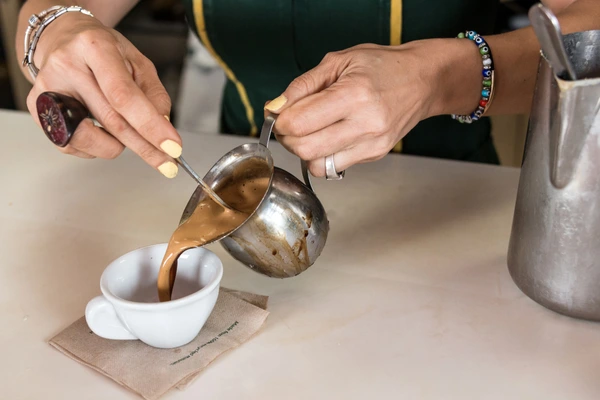For a long time, I assumed Cuban coffee was just another version of espresso. I’ve tried every kind of espresso drink and still prefer the straight shot with nothing added, so I didn’t expect much to surprise me. That changed when a friend, an espresso devotee himself, came back from Cuba raving about the coffee there. His story pushed me to explore it, and after years of experimenting, I’ve learned what makes Cuban coffee different and why it’s an experience worth trying.
What Makes Cuban Coffee Different?
Cuban coffee is different from other types because of how it’s sweetened, the darker roast it uses, the way it’s enjoyed, and what it represents in the culture. It also stands out in how it’s served. Let’s take a closer look at each of these.
Espuma Sweetener
Espuma is the signature foam that sets Cuban coffee apart. To make it, you collect the very first drops from the moka pot as the coffee begins to brew. These concentrated drops are poured into a separate cup with sugar and whipped quickly until the mixture turns light and creamy.
While the rest of the coffee finishes brewing, the espuma holds its form. You can spoon it into the bottom of each serving cup or layer it on top once the coffee is poured. Either way, it blends evenly and creates the sweet, foamy finish Cuban coffee is known for.
Espuma adds sweetness that blends evenly through the cup. The foam gives the drink a smooth surface and a silky mouthfeel, softening the intensity of the dark roast.
Intensity and Roast
Cuban coffee is almost always made with a dark roast. This darker profile gives the brew its signature strength and makes it ideal for pairing with the sweetness of espuma.
And here is why it matters: a lighter roast highlights acidity and floral or fruity notes. A darker roast trades those for boldness, with less brightness but more body and bitterness.
The moka pot (brewing tools usually used for Cuban coffee) adds another layer of intensity. It brews by forcing hot water through tightly packed grounds under pressure. The result is a concentrated shot that looks and feels similar to espresso but comes from the stove instead of a machine. This method pulls strong flavors and a dense texture that fit perfectly with the Cuban coffee style.
You may find it interesting what makes Cuban coffee so strong.
Cultural Ritual
Coffee in Cuba is rarely a solitary drink. It’s typically served in small demitasse cups and shared among friends, family, or coworkers. People gather for a quick cafecito at home, in offices, or even on street corners. The act of drinking together is as important as the coffee itself.
Coffee was first brought to Cuba in the mid-18th century, introduced by Spanish colonists and later expanded by French settlers fleeing Haiti. The island’s fertile soil and climate made it a natural fit for cultivation. Over time, coffee became woven into daily life, not just as an agricultural product but as a social tradition.
One of the most recognizable expressions of this tradition is the colada, a large batch of Cuban coffee served in a central container with small plastic cups for sharing. A colada isn’t meant for one person. It symbolizes hospitality, community, and the idea that coffee is better when passed around. Today it remains a cultural staple, reflecting both history and togetherness.
Typical Serving Styles
Cuban coffee comes in several variations, each with its own place in daily life:
- Cafecito: A small, sweet shot of espresso-like coffee, made with espuma on top. This is the classic everyday serving.
- Colada: A larger batch brewed for sharing, usually poured into small cups so a group can enjoy it together.
- Cortadito: A shot of Cuban coffee “cut” with a splash of milk, softening the intensity while keeping the sweet edge.
- Café con leche: A full cup where Cuban coffee is mixed with hot milk, often served at breakfast alongside bread or pastries.
FAQ
Is Cuban coffee the same as espresso?
No. Cuban coffee is brewed in a moka pot, not an espresso machine. The method produces a concentrated shot similar to espresso but with slightly less pressure and a heavier body.
What type of beans are best for Cuban coffee?
Dark roast beans are the standard choice. They provide a bold flavor and dense body that balance well with the sugar in the espuma.
Why is Cuban coffee so sweet?
The sweetness comes from the espuma, which is made by whipping the first drops of strong coffee with sugar. This creates a foamy paste that blends evenly into the drink.
Key Takeaways
Cuban coffee is a mix of flavor, method, and tradition that creates a unique experience.
- Whipped sugar and the first drops of coffee create a foamy paste that adds sweetness and texture.
- Cuban coffee favors darker roasts, delivering bold flavor and a dense body that pairs well with sugar.
- The stovetop method produces a concentrated shot, similar to espresso but crafted without a machine.
- Coffee is shared in small cups, often as a colada for groups, symbolizing community and connection.

